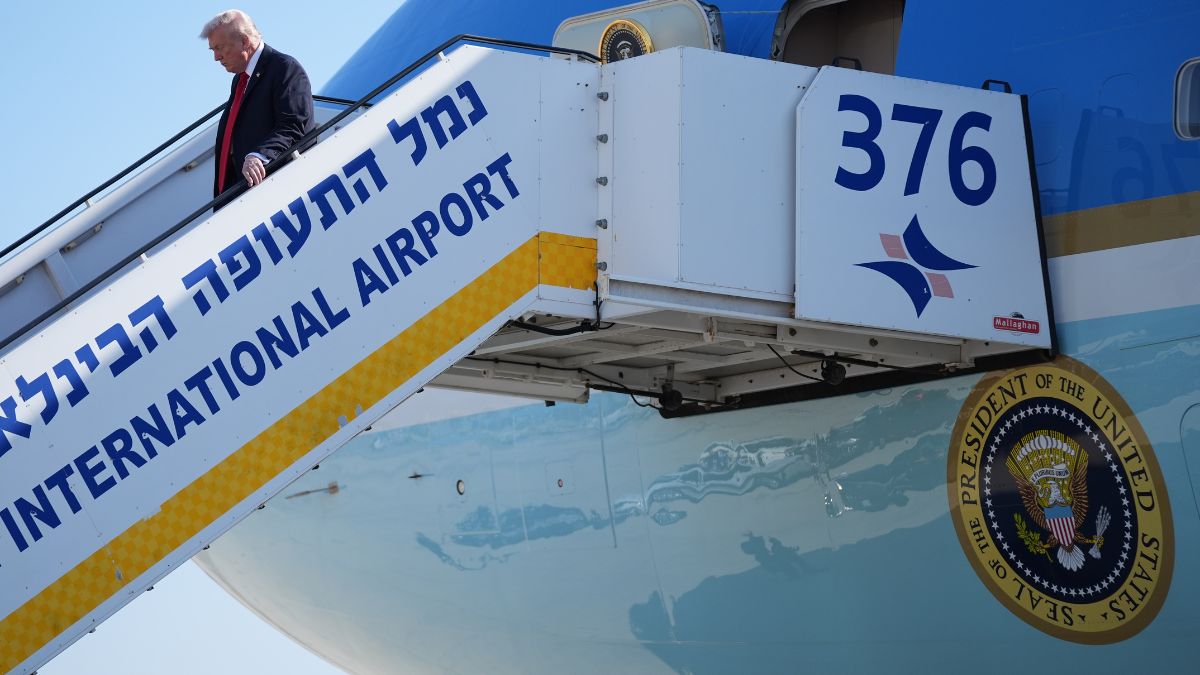From Air Force One: Trump orchestrates Gaza ceasefire and diplomatic peace push
 President Donald Trump arrives at Ben Gurion International Airport, Monday, Oct. 13, 2025, near Tel Aviv | AP
President Donald Trump arrives at Ben Gurion International Airport, Monday, Oct. 13, 2025, near Tel Aviv | AP
US President Donald Trump has declared “the war is over” as he travels to Israel in support of the ceasefire agreement between Israel and Hamas, which includes a significant hostage exchange. Speaking from Air Force One, Trump expressed confidence in the deal, stating that the truce would hold and that a “Board of Peace” would soon be established for the Gaza Strip. He described Gaza as resembling a “demolition site” but reiterated his belief that the situation could be turned around, echoing his past remarks that Gaza had the potential to become the “Riviera of the Middle East”. He also credited Israeli Prime Minister Benjamin Netanyahu and Qatar for their roles in brokering the deal.
The hostage and detainee exchange forms the centrepiece of Trump’s 20-point plan to end the conflict. Israel expects to receive 20 of its citizens alive from Gaza later today.. These hostages are among the 48 people still believed to be held in the territory. Once released, they will be transported in Red Cross vehicles before being taken either to a military base for family reunions or directly to hospitals if medical attention is needed. Israel has even conducted simulation drills with actors to prepare hospitals for the incoming hostages.
In return, Israel is preparing to release nearly 2,000 Palestinian detainees. This includes approximately 1,700 from Gaza and 250 others who have been long-term prisoners. Some of the latter are regarded as prominent Palestinian figures, though notable individuals requested by Hamas, such as Marwan Barghouti and the doctors Hussam Abu Safiya and Marwan al-Hams, are not part of the initial release. Many of those being freed will be relocated either back to Gaza or sent into exile in neighbouring countries. Israeli authorities have reportedly instructed the families of released detainees to refrain from public celebrations and to limit contact with the media.
Trump’s visit marks the start of a broader diplomatic push aimed at securing a permanent peace in the region. During his stay, he plans to address the Knesset and meet the families of freed hostages. He will later travel to Sharm el-Sheikh in Egypt to co-chair a peace summit with Egyptian President Abdel-Fattah el-Sisi. The summit aims to finalise a lasting truce and move towards a postwar framework for Gaza. Trump has presented this ceasefire as a turning point, claiming there is widespread celebration in both Israel and across the Arab world.
The United States intends to build on the momentum of the Abraham Accords by encouraging further normalisation of relations between Israel and key regional players such as Saudi Arabia and Indonesia. However, the challenge of rebuilding Gaza looms large. Years of war have left the territory in ruins, with over 67,000 Palestinians killed and roughly 170,000 injured. Most of Gaza’s infrastructure has been destroyed, and large parts of the population are displaced or in desperate need.
As part of the ceasefire agreement, the flow of humanitarian aid into Gaza is set to resume at scale. The Israeli military agency responsible for aid coordination anticipates about 600 trucks a day entering the strip, matching prewar volumes. The United Nations has 170,000 metric tonnes of food, medicine, and other supplies ready to be delivered. The World Food Programme has confirmed that road clearance and repair are underway to facilitate aid distribution. However, the urgency of the situation is stark. The world’s leading authority on food crises has declared a famine in parts of Gaza, though Israel rejects this claim and accuses the reporting body of relying on misinformation.
Adding to the complications is uncertainty over the role of the Gaza Humanitarian Foundation, which was originally proposed to replace the UN in aid coordination. The foundation has been criticised for its militarised approach, leading to the deaths of more than a thousand people during deliveries.
Moreover, many critical aspects of the postwar framework are yet to be agreed upon, including the disarmament of Hamas, the future governance of Gaza, and the withdrawal of Israeli forces. Prime Minister Netanyahu has stated that the military will continue its mission to dismantle Hamas even after the hostages are returned, describing the group as having “a sword on its neck”.
Adding to the concern is the fact that Hamas is redeploying thousands of its members to regain control in areas recently vacated by Israeli troops. Internal clashes have already broken out in Gaza City, including a deadly confrontation between Hamas forces and members of the Dughmush family, one of Gaza’s most influential clans, resulting in dozens of fatalities.
Middle East